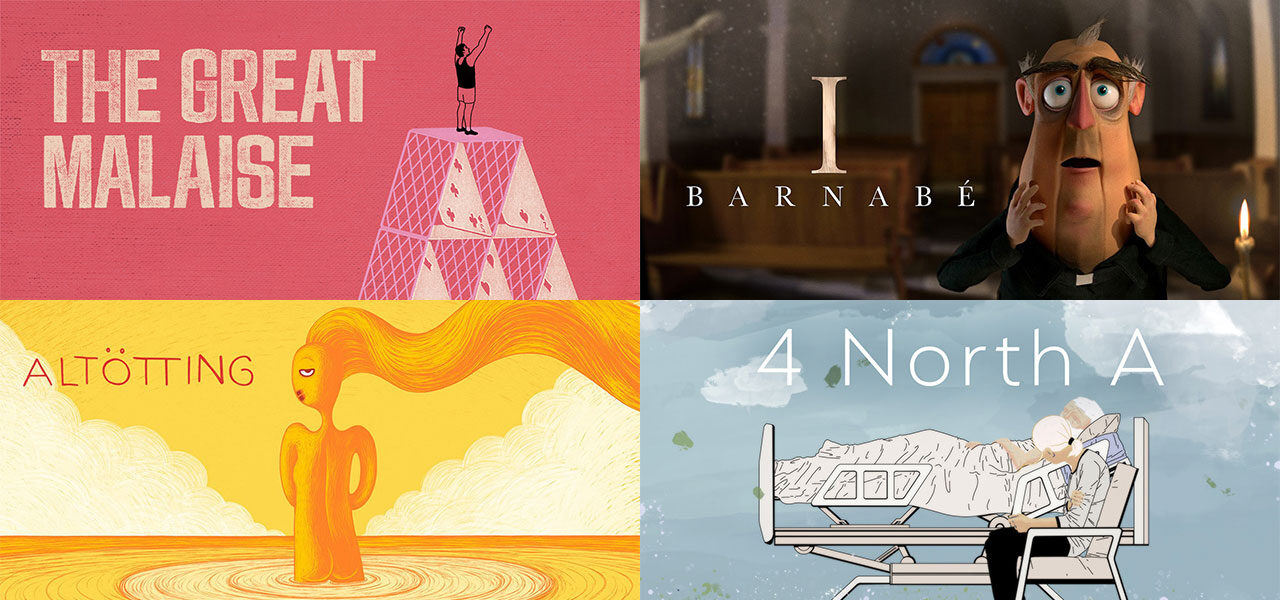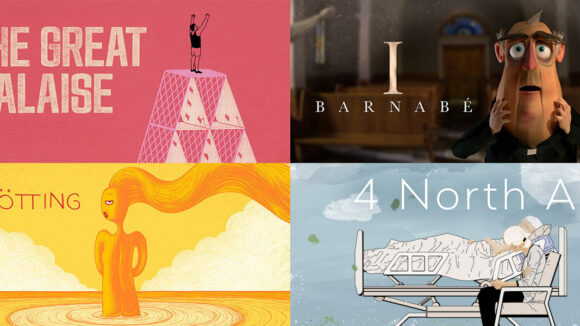

A Quartet Of Hope: The Striking Thematic Parallels That Link The NFB’s Four Shorts
Not even a pandemic could slow down the mighty National Film Board of Canada (NFB) in 2020. Canada’s globally acclaimed public animation studio produced a number of strong animated films during the past year, notably a quartet of shorts that have garnered many awards and glowing critical acclaim.
The Great Malaise, Catherine Lepage’s debut animated film, is a playful, personal take on mental health. At the film’s premiere at Les Sommets du cinéma d’animation, The Great Malaise won both the People’s Choice Award and the Jury’s Special Mention. It also screened at the Berlinale.
Jean-François Lévesque’s I, Barnabé (an NFB production, with the participation of ARTE France) is a portrait of a priest struggling with his spirituality. It screened at Annecy and won awards at Ottawa (Best Technique) and Valladolid (Best Short Film).
Andreas Hykade’s Altötting, a nostalgic tale about a boy’s attraction to the Virgin Mary, has played at the major animation festivals, taking home a Grand Prize from Portugal’s Cinanima Festival and Best Script from Ottawa.
And Jordan Canning’s and Howie Shia’s heart-wrenching 4 North A, about a woman sitting at the bedside of her dying father, has moved audiences at TIFF, Ottawa, and other festivals.
This powerful quartet stand out for their inspired technical and stylistic approaches, as well as their timeless, universal themes of mortality, spirituality, anxiety, and identity. Despite their unique techniques, voices, and origins, these films feel loosely connected, in that they consider our place in the larger scheme of existence.
The Great Malaise
A playful meditation on depression and anxiety, Catherine Lepage’s The Great Malaise originated as a series of graphic novels. Lepage worked as an illustrator and graphic book author before turning to animation to adapt her books.
Presented as a series of tableaus, The Great Malaise follows an initially confident young woman’s voice as she speaks of her poise, success, hard work, and ambitions over a series of images that match her self-assurance. Very quickly that changes as the images become out of sync and the voice slows, cracks, and hesitates. By the final image (of a burned-out matchstick), all that exuberant self-confidence has collapsed into self-doubt.
Lepage’s use of minimalist drawings with backgrounds that appear stained and faded enhances the sense that we’re witnessing a person succumbing to the grip of depression.
I, Barnabé
I, Barnabé by Jean-François Lévesque (The Necktie, 2008) almost feels like a thematic sequel to The Great Malaise: why are we depressed and anxious? Is it because we’ve lost touch with spirituality? The film is about a priest who has lost his way in a world that has turned away from religion — and, with that, from spirituality.
This technological wonder (which fuses stop motion, computer, drawings, and beautiful experimental techniques) explores Barnabé’s existential meltdown via the figure of a rooster who appears to him during a day of binge drinking. What is left in a world where people have left the church and the notion of deities for rapid material satisfaction?
I, Barnabé (which took more than seven years to create) is a dense film, open to multiple interpretations. It can be read as a nervous breakdown, a loss of identity, a portrait of addiction, or a tale about how we need to acknowledge our so-called “dark side.” But ultimately, it comes back to a human being in need of an existential recalibration.
Interpretations aside, I, Barnabé is a visual feast. There are puppets, drawings, a beautiful stained-glass sequence, and a technique that involved filming fluids as they’re poured into a glass tank. As different as each technical approach is, they all fit seamlessly into the narrative.
Particularly impressive is Lévesque’s use of lighting. The film’s lighting technique involved individually exposed lighting passes (ranging from 5 to 12 passes per shot!). With each repositioning of the puppet, the lighting was also adjusted. This enabled Lévesque to later adjust the lighting on each scene without having to re-animate.
Altötting
Altötting (a co-production between Studio Film Bilder, the NFB, and Ciclope Filmes) was created by acclaimed animator Andreas Hykade. It also explores religion and spiritually from a very personal viewpoint, but with a slightly different perspective and tone.
Drawing on his childhood in the Bavarian village Altötting, where there’s a shrine to the Virgin Mary, Hykade remembers his younger infatuation with the church and specifically Mary. As he grows older he discovers the horrid truth behind the Virgin Mary’s eternal beauty and realizes that it’s time to move on from the illusions of his youth.
Fans of Hykade’s work will immediately recognize his distinctive minimalist design and deadpan humor. Throughout his career, Hykade has hopped back and forth between restrained, uncluttered work (e.g. Nuggets) and more conceptually and visually elaborate works (notably We Lived in Grass and Ring of Fire). In Altötting, Hykade bridges these worlds by weaving his iconic design with flourishes of bold, opulent beauty into a deeply personal yet timeless and hopeful story of lost innocence.
One of the most chilling and powerful moments in Altötting occurs when the Virgin Mary reveals her dark secret to the boy (now a young man). In creating this intricate scene, Hykade turned to award-winning animator Regina Pessoa (Uncle Thomas: Accounting for the Days). Rather than attempt a copy of Pessoa’s distinctive engraving technique, Hykade went right to the source. “I needed Regina’s contribution,” adds Hykade, “so that she could put her holy scratches on top of the animation. Now, it’s quite magical and alive.”
4 North A
4 North A, by Howie Shia and Jordan Canning, seems like an odd collaboration. Shia is an established animator who has worked with Disney and Nike but has also made films with the NFB, including Flutter (2006) and the award-winning BAM (2015).
Canning is best known as a live-action writer and director (We Were Wolves). She’s also directed episodes of the hit Canadian tv shows Schitt’s Creek and The Baroness Von Sketch Show.
Surrounded by sounds from hospital corridors and the cries of grieving strangers, a woman sits alone in a hospital room with her dying father. As the woman struggles with her emotions, she drifts back and forth between her antiseptic present and a series of bittersweet memories from her childhood. Inspired by Canning’s own experiences, 4 North A is deeply personal yet instantly relatable to anyone — especially during a pandemic — who has experienced illness or loss.
What stands out in 4 North A is its quiet yet expressive soundtrack (beautifully created by Sacha Ratcliffe) that captures and somehow humanizes the cold, mechanical sounds of the sterile hospital setting.
Visually, Shia’s striking yet subdued design swings between the pale palette of the hospital environment and the livelier, painterly landscapes of the woman’s childhood memories.
4 North A is not easy on the heartstrings, yet there is an abundance of optimism to be found through the tears. The film is about loss, but also about finding comfort in others. Even during our toughest moments, we can still connect and comfort each other.
These shorts, despite their melancholic tendencies, are united by optimism. They gently encourage us to step back, take a deep breath, and re-evaluate our priorities. At the same time, they remind us of the importance of genuine connection — not with screens, but with people, nature, and, ultimately, ourselves.
